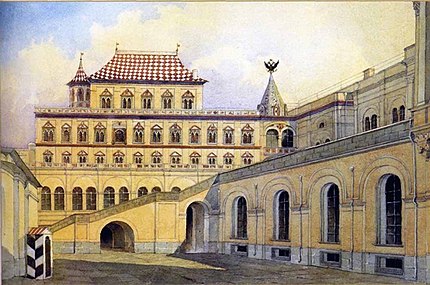|
Karl Rabus Karl Wilhelm Rabus, russified as Karl Ivanovich Rabus (Russian: Карл Ива́нович Ра́бус; 11 May 1800, St. Petersburg - 14 January 1857, Moscow) was a Russian architectural painter and art teacher. BiographyHis father died when Karl was seven. At the age of only ten, he was sent to study at the Imperial Academy of Arts; remaining there until 1821, when he received a small gold medal and a second-degree certificate.[2] Crimea became one of his favorite places to paint. There, he created the works necessary for him to obtain the title of "Academician" by painting landmarks in a manner that would later become known as en plein aire. He was awarded the title in 1827 for his canvas depicting a villa in Gurzuf, built by the Duc de Richelieu. He also received praise for his view of Balaklava. From Crimea, he went to Odessa, then spent some time in Istanbul.[3] In 1835, he moved to Moscow and became a teacher of perspective, at the Palace School of Architecture. Later, he taught the same subject at the Konstantinov Land Survey Institute. He also taught a few classes in the theory of colors and art history. Sometimes, he would offer financial support to his most promising students. A painting of the village church in Ismailovo was presented at court; obtaining him the title of Court Painter. In his later years, he tried his hand at writing; producing "A Guide to Perspective" and beginning a history of art. He also provided commentary on art for several magazines and newspapers.[3] During those years, he taught landscape painting at the Stroganov School and the Moscow School of Painting, Sculpture and Architecture.[2] Toward the end of his life, he suffered from a type of color blindness (possibly due to glaucoma), that left him unable to distinguish orange and yellow shades.[citation needed] He died after an unspecified long and serious illness. Selected paintings
References
Further reading
External links
|
Portal di Ensiklopedia Dunia


![Transfiguration Church at the Alexeyevsky Monastery [ru]](http://upload.wikimedia.org/wikipedia/commons/thumb/0/0b/%D0%A0%D0%B0%D0%B1%D1%83%D1%81_%D0%9A%D0%B0%D1%80%D0%BB_%D0%98%D0%B2%D0%B0%D0%BD%D0%BE%D0%B2%D0%B8%D1%87_-_%D0%9F%D1%80%D0%B5%D0%BE%D0%B1%D1%80%D0%B0%D0%B6%D0%B5%D0%BD%D1%81%D0%BA%D0%B0%D1%8F_%D1%86%D0%B5%D1%80%D0%BA%D0%BE%D0%B2%D1%8C_%D0%B2_%D0%90%D0%BB%D0%B5%D0%BA%D1%81%D0%B5%D0%B5%D0%B2%D1%81%D0%BA%D0%BE%D0%BC_%D0%BC%D0%BE%D0%BD%D0%B0%D1%81%D1%82%D1%8B%D1%80%D0%B5_%281838%29.jpg/419px-%D0%A0%D0%B0%D0%B1%D1%83%D1%81_%D0%9A%D0%B0%D1%80%D0%BB_%D0%98%D0%B2%D0%B0%D0%BD%D0%BE%D0%B2%D0%B8%D1%87_-_%D0%9F%D1%80%D0%B5%D0%BE%D0%B1%D1%80%D0%B0%D0%B6%D0%B5%D0%BD%D1%81%D0%BA%D0%B0%D1%8F_%D1%86%D0%B5%D1%80%D0%BA%D0%BE%D0%B2%D1%8C_%D0%B2_%D0%90%D0%BB%D0%B5%D0%BA%D1%81%D0%B5%D0%B5%D0%B2%D1%81%D0%BA%D0%BE%D0%BC_%D0%BC%D0%BE%D0%BD%D0%B0%D1%81%D1%82%D1%8B%D1%80%D0%B5_%281838%29.jpg)
